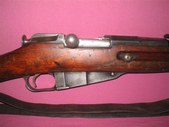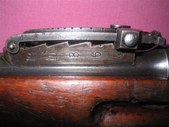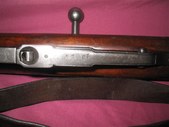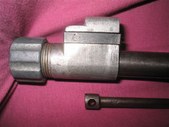
1
Receiver tang markings indicating 1904 Izhevsk manufacture.
| 
2
Buttstock with buttplate removed to show repairs. Notice the plywood re-inforcing, the toe splice, the dowel splice and the left side of the buttstock spliced over with a walnut patch.
| 
3
Serial number, SA stamp and CG district number.
| 
4
Full length view of rifle.
|

5
buttstock. Notice the repaired toe, remnants of a tsarist roundel and a CG district number.
| 
6
stock wrist
| 
7
action view.
| 
8
right side of barrel chamber area.
|

9
| 
10
front end of rifle with muzzle cover in place.
| 
11
buttstock showing walnut stock patch.
| 
12
left view of action.
|

13
| 
14
Notice the Finnish sling hangers
| 
15
Notice the front handguard crossbolt, an early C.G. modification to M24's and some M91's in CG service.
| 
16
Note the CG crest, the tsarist receiver eagle, the "Christmas tree" marking and the CG district number.
|

17
Note that on this rifle, the Russian Arshin measurements are not cancelled out.
| 
18
Here we have the ranges in metric added by the Finns. Also note, the sight is not modified for a 150 meter range.
| 
19
SIG markings on the barrel.
| 
20
bolt, renumbered matchign by the Finns at the time the rifle was built.
|

21
HV = jamb free operation magazine, a Finn invention.
| 
22
mag floorplate.
| 
23
oval-buckle sling.
| 
24
SA cartouche on the sling.
|

25
nosecap area and front band cross bolt.
| 
26
Note that the M24 retained the Russian type rear band retention stud.
| 
27
Muzzle cover affixed.
| 
28
Note the early unstepped front sight blade.
|

29
Note the =S= civil guard acceptance stamp on th cover.
| 
30
cap removed.
| 
31
maker's marking on cap - meaning unknown
| 
32
|

33
buttplate tang and small stock repair at the bottom of the picture.
| 
34
Bottom of plywood reinforcement in buttstock.
| |

